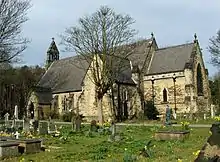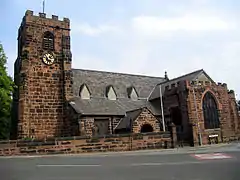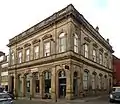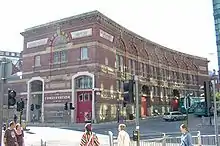List of extant works by Culshaw and Sumners
Culshaw and Sumners was a firm of English architects and surveyors who practised in Liverpool in the 19th and early 20th centuries. It was founded in the 1830s by William Culshaw (1807–74), who was joined by Henry Sumners (1825–95) in 1861. Their partnership was dissolved in 1873 when Sumners was replaced by Culshaw's son, Alfred (1849/50–1926), who continued to run the practice until 1916. The practice carried out much mundane and routine work, but also designed new buildings, some of which are considered to be notable. Their output included office blocks, warehouses, domestic properties, workhouses, churches, and a hospital.[1]
This list includes the existing buildings of the architects that have been listed, and/or are included in the Buildings of England series. The buildings designed by Culshaw alone are denoted by † in the "Name" column, those of Sumners by ‡, and the single work of William Culshaw & Son by ¶.
Key
| Grade | Criteria[2] |
|---|---|
| Grade II* | Particularly important buildings of more than special interest. |
| Grade II | Buildings of national importance and special interest. |
Works
| Name | Location | Image | Date | Notes | Grade |
|---|---|---|---|---|---|
| 68 and 70 Upper Parliament Street † | Liverpool 53.3957°N 2.9691°W |
1841 | Two houses in a terrace; designed for the shipbuilder Thomas Royden.[3][4][5] | II | |
| 16 and 18 Croxteth Road | Liverpool 53.3890°N 2.9512°W |
1843 | A pair of semi-detached houses in Italianate style.[3][6] | II | |
| Abbey National building † | Ranelagh Street, Liverpool 53.4051°N 2.9805°W |
1843 | A building in Neoclassical style, faced in stucco, with giant pilasters.[7][8] | — | |
| St James' Church † | St James Place, Toxteth, Liverpool 53.3943°N 2.9748°W |
 |
1846 | Culshaw replaced the roof of the church which was built in 1774–75 by Cuthbert Brown.[9][10] | II* |
| Frankby Hall † | Frankby, Wirral, Merseyside 53.3689°N 3.1395°W |
1846–47 | Built as a castellated and turreted house; in 1938–39 converted into cemetery chapels.[11] | — | |
| Offices † | Tempest Hey, Liverpool 53.4085°N 2.9908°W |
1849 | An office block for the bankers Messrs Rowlinson.[12] | — | |
| 3 Huskisson Street | Liverpool 53.3973°N 2.9681°W |
1850s–60s | A house built in 1839 for Revd John Jones, altered for Isaac Hadwen junior.[13] | — | |
| Ormskirk workhouse † | Ormskirk, Lancashire 53.5666°N 2.8761°W |
1851–53 | Built for the Ormskirk Poor Law Union, consisting of an octagonal centre with three arms. Later incorporated into Ormskirk Hospital.[14][15] | — | |
| St Luke's Church † | Formby, Sefton, Merseyside 53.5521°N 3.0874°W |
 |
1852–55 | A new church built close to the site of an ancient chapel.[16][17] | II |
| Baltic Fleet public house † | Wapping, Liverpool 53.3986°N 2.9867°W |
 |
1853 | Culshaw designed the first phase.[18][19][20] | II |
| Maer Hall † | Maer, Staffordshire 52.9420°N 2.3109°W |
 |
1853 | The house dates from the middle of the 17th century. Culshaw added a wing for William Davenport, which has since been demolished.[21][22][23] | II |
| St Luke's Church † | Farnworth, Widnes, Cheshire 53.3844°N 2.7273°W |
 |
1855 | Restoration, including rebuilding the north aisle and arcade.[24][25] | II* |
| Warehouse † | 66 Bridgewater Street, Liverpool 53.3964°N 2.9829°W |
1857 | One of Culshaw's few surviving warehouses.[26] | — | |
| Mossley Vale † | North Mossley Hill Road, Mossley Hill, Liverpool 53.3821°N 2.9231°W |
1858 | A house, later used as the music and arts department of Liverpool College.[27] | — | |
| Furniture workshops and showrooms ‡ | Nelson Street, Liverpool 53.3999°N 2.9769°W |
 |
c. 1858 | A building in Neoclassical style, with elaborate stucco.[28] | — |
| Holly Lodge † | West Derby, Liverpool 53.4269°N 2.9166°W |
1860 | Addition made to a house built about 1830, consisting of wing in Italianate style, with a belvedere tower and a billiards room. Since 1912 it has been used as a school.[18][29] | — | |
| Liverpool Savings Bank † | Bold Street, Liverpool 53.4024°N 2.9765°W |
 |
1861 | Originally the head office of the savings bank, this is a four-storey building in Italianate style.[30][31] | — |
| 16–17 Beach Lawn ‡ | Waterloo, Merseyside 53.4774°N 3.0362°W |
1861 | Two houses in High Victorian Gothic style built for Dr Drysdale.[32][33][34][35] | II | |
| Abbots Lea † | Beaconsfield Road, Woolton, Liverpool 53.3820°N 2.8824°W |
1862 | A large Gothic-style house, in red sandstone, with a 20th-century expansion.[36] | — | |
| 19 Abercromby Square † | Liverpool 53.4033°N 2.9644°W |
1862–63 | A building of seven bays, and higher than its neighbours, this was designed for C. K. Prioleau. It was altered in the 1880s to become the Bishop's Palace, and in the 20th century became the centre for the Department of Education and the Department of Corporate Communications of the University of Liverpool. It is described as "perhaps the grandest surviving 19th-century house in the city centre".[37][38] | II | |
| National Bank | Cook Street, Liverpool 53.4062°N 2.9892°W |
1863 | A building in five bays, in Italianate style.[39] | — | |
| West Derby Union workhouse ‡ | Walton, Liverpool |  |
1863 | A symmetrical building in three storeys, with 23 bays, plus four-bay wings at each end, and a central clock tower. Later used as Walton Hospital; from 2005 converted into apartments.[40][41][42] | II |
| Berey's Buildings ‡ | Bixteth Street, Liverpool 53.4090°N 2.9920°W |
1864 | An office block in ten bays by six bays, constructed in red brick with sandstone bands and a grey stone basement. It has Gothic features, plus square-headed windows. The building has been converted into flats.[43] | — | |
| St John's Church † | Waterloo, Merseyside 53.4766°N 3.0298°W |
1864–65 | A new church in Early English style.[44][45] | II | |
| Sodylt Hall † | Dudleston, Shropshire 52.95834°N 2.9755°W |
1865 | Additions to a house dating from the 18th century.[46] | — | |
| Quarry Bank House | Allerton, Liverpool 53.3827°N 2.9012°W |
 |
1866–67 | A house in Gothic style, later developed as part of Calderstones School.[47][48] | II |
| Christ Church, Toxteth Park | Linnet Lane, Liverpool 53.3848°N 2.9486°W |
 |
1867–71 | A new church in Decorated style with a steeple.[49][50][51] | II |
| North Lodge and gates | Gyrn Castle, Llanasa, Flintshire, Wales 53.3256°N 3.3350°W |
1868 | Built for Sir Edward Bates, Liverpool merchant and ship-owner.[52][53] | II | |
| Greek Orthodox Church ‡ | Toxteth, Liverpool 53.3954°N 2.9671°W |
 |
1870 | The church is in Neo-Byzantine style with four domes and round-arched windows. The competition for its design was won by W. and J. Hay, but the construction was supervised by Sumners.[54][55] | II |
| Midland Railway goods warehouse ‡ | Whitechapel and Crosshall Street, Liverpool 53.4077°N 2.9848°W |
 |
1872–74 | Built as a goods warehouse for the Midland Railway, with an addition in Peter Street in 1878. It was converted into a conservation centre for National Museums Liverpool in about 1995.[56][57][58] | II |
| Town Hall ‡ | St Helens, Merseyside 53.4542°N 2.7353°W |
 |
1873–76 | Built in brick with much in the way of stone dressings, it is in Gothic style. The original asymmetrically placed spire burnt down in 1913 and has been replaced by a tower.[59] | — |
| Wesleyan Chapel ¶ | Broughton-in-Furness, Cumbria 54.2772°N 3.2112°W |
1875 | Complex of chapel, hall and kitchen in Gothic style, with a double bellcote.[60] | — | |
| South Block, Cowley High School ‡ | St Helens, Merseyside 53.4591°N 2.7461°W |
1875–82 | Built as an extension to the school, unoccupied by 1992, severely damaged by fire 1993.[61][62] | II | |
| St Cyprian's Church ‡ | Edge Hill, Liverpool 53.4080°N 2.9480°W |
 |
1879–81 | Designed by Sumners, with many unusual features, including elements of Romanesque and Arts and Crafts styles.[63][64] | II |
| St Luke's Art Workshops ‡ | Myrtle Street, Liverpool 53.4013°N 2.9686°W |
 |
1880 | Built for Norbury, Upton and Paterson, architectural carvers.[65] | — |
References
- Sharples 2012, pp. 49–75.
- Listed Buildings, Historic England, retrieved 29 March 2015
- Sharples 2012, p. 57.
- Historic England, "68 Upper Parliament Street, Liverpool (1359860)", National Heritage List for England, retrieved 11 September 2012
- Historic England, "70 Upper Parliament Street, Liverpool (1292000)", National Heritage List for England, retrieved 11 September 2012
- Historic England, "16 and 18 Croxteth Road, Liverpool (1068271)", National Heritage List for England, retrieved 11 September 2012
- Sharples 2012, p. 48.
- Sharples & Pollard 2004, p. 182.
- Sharples & Pollard 2004, p. 270.
- Historic England, "Church of St James, Liverpool (1209882)", National Heritage List for England, retrieved 11 September 2012
- Hartwell et al. 2011, pp. 359–360.
- Sharples & Pollard 2004, p. 163.
- Sharples & Pollard 2004, p. 250.
- Sharples 2012, p. 73.
- Pollard & Pevsner 2006, p. 534.
- Pollard & Pevsner 2006, p. 172.
- Historic England, "Church of St Luke, Formby (1343284)", National Heritage List for England, retrieved 10 September 2012
- Sharples 2012, p. 58.
- Sharples & Pollard 2004, p. 113.
- Historic England, "Baltic Fleet public house, Wapping, Liverpool (1218452)", National Heritage List for England, retrieved 11 September 2012
- Sharples 2012, pp. 51, 58.
- Pevsner 1974, p. 201.
- Historic England, "Maer Hall (1206392)", National Heritage List for England, retrieved 10 September 2012
- Pollard & Pevsner 2006, pp. 653–655.
- Historic England, "Church of St Luke, Farnworth (1130417)", National Heritage List for England, retrieved 11 September 2012
- Sharples 2012, pp. 59–60.
- Pollard & Pevsner 2006, p. 443.
- Pollard & Pevsner 2006, p. 207.
- Pollard & Pevsner 2006, p. 504.
- Sharples 2012, p. 62.
- Sharples & Pollard 2004, p. 197.
- Sharples 2012, pp. 63–64.
- Pollard & Pevsner 2006, p. 645.
- Historic England, "16 Beach Lawn, Sefton (1257667)", National Heritage List for England, retrieved 11 September 2012
- Historic England, "17 Beach Lawn, Sefton (1257675)", National Heritage List for England, retrieved 11 September 2012
- Pollard & Pevsner 2006, p. 514.
- Sharples & Pollard 2004, p. 217.
- Historic England, "18 and 19 Abercromby Square, Liverpool (1356239)", National Heritage List for England, retrieved 10 September 2012
- Sharples & Pollard 2004, p. 144.
- Sharples 2012, pp. 72–73.
- Pollard & Pevsner 2006, p. 491.
- Historic England, "Walton Hospital (original part only) (1361912)", National Heritage List for England, retrieved 11 September 2012
- Sharples & Pollard 2004, pp. 19, 134.
- Pollard & Pevsner 2006, p. 643.
- Historic England, "Church of St John, Sefton (1257359)", National Heritage List for England, retrieved 10 September 2012
- Newman & Pevsner 2006, p. 253.
- Pollard & Pevsner 2006, p. 389.
- Historic England, "Quarry Bank House, Liverpool (1207414)", National Heritage List for England, retrieved 11 September 2012
- Sharples 2012, pp. 69–70.
- Sharples & Pollard 2004, pp. 23, 280.
- Historic England, "Christ Church, Liverpool (1346251)", National Heritage List for England, retrieved 10 September 2012
- Hubbard 1986, p. 383.
- Cadw, "Gateway and gates at N entrance to Gyrn Castle (25112)", National Historic Assets of Wales, retrieved 11 April 2019
- Sharples & Pollard 2004, pp. 24, 245.
- Historic England, "Greek Orthodox Church, Liverpool (1280650)", National Heritage List for England, retrieved 11 September 2012
- Sharples 2012, p. 67.
- Sharples & Pollard 2004, pp. 190–191.
- Historic England, "Midland Railway goods offices, Liverpool (1062567)", National Heritage List for England, retrieved 11 September 2012
- Pollard & Pevsner 2006, p. 557.
- Hyde & Pevsner 2010, p. 200.
- Pollard & Pevsner 2006, p. 564.
- Historic England, "Cowley High School, South Block, St Helens (1241408)", National Heritage List for England, retrieved 11 September 2012
- Pollard & Pevsner 2006, p. 410.
- Historic England, "Church of St Cyprian, Liverpool (1356350)", National Heritage List for England, retrieved 11 September 2012
- Pollard & Pevsner 2006, p. 236.
Bibliography
- Hartwell, Claire; Hyde, Matthew; Hubbard, Edward; Pevsner, Nikolaus (2011) [1971], Cheshire, The Buildings of England, New Haven and London: Yale University Press, ISBN 978-0-300-17043-6
- Hubbard, Edward (1986), Clwyd, The Buildings of Wales, London: Penguin, ISBN 0-14-071052-3
- Hyde, Matthew; Pevsner, Nikolaus (2010) [1967], Cumbria, The Buildings of England, New Haven and London: Yale University Press, ISBN 978-0-300-12663-1
- Newman, John; Pevsner, Nikolaus (2006), Shropshire, The Buildings of England, New Haven and London: Yale University Press, ISBN 0-300-12083-4
- Pevsner, Nikolaus (1974), Staffordshire, The Buildings of England, Harmondsworth: Penguin Books, ISBN 0-14-071046-9
- Pollard, Richard; Pevsner, Nikolaus (2006), Lancashire: Liverpool and the South-West, The Buildings of England, New Haven and London: Yale University Press, ISBN 0-300-10910-5
- Sharples, Joseph; Pollard, Richard (2004), Liverpool, Pevsner Architectural Guides, New Haven and London: Yale University Press, ISBN 0-300-10258-5
- Sharples, Joseph (2012), "William Culshaw (1807–74) and Henry Sumners (1825–95): rebuilding Victorian Liverpool", in Webster, Christopher (ed.), The Practice of Architecture: eight architects, 1830–1930, Spire Studies in Architectural History, 2, Reading: Spire Books, ISBN 978-1-904965-35-0